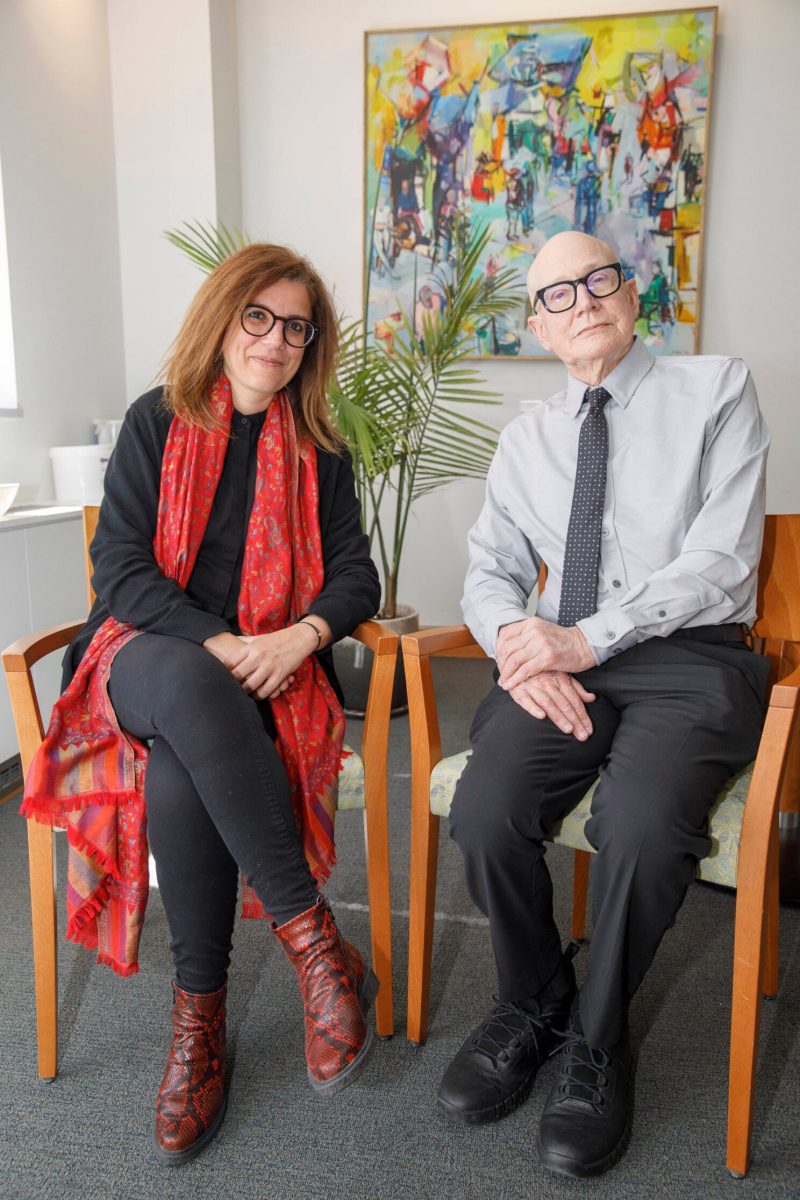Joelle Abi-Rached and Allan Brandt discussed their contribution to the NEJM series on key historical injustices in medicine, including the rise of Nazi Germany.
Kris Snibbe/Harvard Staff Photographer
Health
How do you read organization’s silence over rise of Nazism?
Medical historians look to cultural context, work of peer publications in wrestling with case of New England Journal of Medicine
In December, one of the world’s leading medical journals, the New England Journal of Medicine, began a process of self-examination, publishing articles about the Journal itself and its handling of a series of key historical injustices in medicine, including eugenics, slavery, oppression of Native Americans, and, in an issue published in April, the rise of Nazi Germany.
One major challenge, according to two medical historians, is how little the NEJM had to say about Nazism and its systematic and genocidal oppression of Europe’s Jews beginning in 1933, when Adolf Hitler came to power.
That came as something of a surprise to Allan Brandt, the Amalie Moses Kass Professor of the History of Medicine and professor of the history of science, and Joelle Abi-Rached, Ph.D. ’17, the Mildred Londa Weisman Fellow at the Radcliffe Institute for Advanced Study. The pair contributed to the series, which was initiated by David Jones, the A. Bernard Ackerman Professor of the Culture of Medicine. Brandt praised the publication for its willingness to face what may be an uncomfortable history.
With so little material available, the two researchers, in a conversation with the Gazette, discussed their dilemma: How do you parse a near silence? This interview was edited for length and clarity.
Knowing the prevailing attitudes toward race and ethnicity in the World War II era and the decade leading up to it, were you expecting to find a complicated situation?
Brandt: Yes. The New England Journal’s effort is very similar to what Harvard did in its exploration of slavery on campus — Harvard faculty and administrators held slaves and did not challenge slavery often. These are the kinds of institutional self-observations that I think are important. It’s often been perceived as a reputational risk in opening up the archives and facing these things. But I think the reputational risk is in not doing it and the Journal very appropriately recognized that.
“We expected that, given the dimensions and the horrors of the Holocaust, we would find that the Journal said a lot during that time. But our initial finding was that there was almost nothing.“
Allan Brandt
When we look at your specific findings, what do you think is most important?
Brandt: When our colleagues were working on other papers in this series and ran their digital investigations, they literally came up with hundreds of hits. For us, the experience was like putting a search term into Google and getting no response. We expected that, given the dimensions and the horrors of the Holocaust, we would find that the Journal said a lot during that time. But our initial finding was that there was almost nothing.
Abi-Rached: The omission, absence, and silence startled us, so we made an extra effort to find anything that was written on the rise of Hitler. We did come across a few items and these became the backbone of the paper. They were illuminating.
One piece published in 1933 is a very short piece that even people who have read our paper have trouble finding. It’s a short communique published at the end of a very long and tedious paper on surgery. The communique, “The Abuse of the Jewish Physicians,” is revealing because the concern was not discrimination or persecution but the fact that these Jewish physicians were dismissed and lost their livelihood. That was the only piece published in 1933.
Then there is a controversial, longer piece published in 1935 by Michael Davis, an eminent health reformer, with a German nurse who later research would reveal was a Nazi sympathizer. And then there was nothing until 1944.
In 1944, the Journal published its first editorial, an important piece in which the Journal takes a stance on the humanitarian disaster that the “Nazi tyranny” had caused in occupied Europe.
Then you have another key article published in 1949, long after the conclusion of the Second World War, by Leo Alexander, who was a Viennese-born neuropsychiatrist who gathered evidence for the trial of the doctors at Nuremberg. So, this absence of debate around the rise of Nazism and its persecutory, racist laws became our guiding thread.
How would you describe what must have been the Journal’s approach during those years?
Brandt: Joelle and I talked about how we could understand silence, or an omission. We speculated about structural or institutional racism and thought about whether, in a medical or scientific journal which is typically reporting clinical findings and new knowledge, it might have been possible for editors to say, “This isn’t really part of our remit. It’s terrible, but that’s not what we do.”
“An important conclusion is that silence is not neutral. It says as much as it hides. Reading the past also tells us something about our contemporary moment, our failings, including our moral failings.“
Joelle Abi-Rached
So we decided to go to other leading journals, Science and the Journal of the American Medical Association, to see if that held up — sometimes you have to go outside to look on the inside. We couldn’t get to it in an article of this length, but I think if we more closely examined Boston medicine at the time, between academics at Harvard Medical School and the Journal, we might have gotten additional insight. It was not a diverse group.
Abi-Rached: The point we make is that the silence, the omission, was not banal. It was not mere ignorance. The discriminatory nature of these policies that were implemented by the Nazi regime were reported in the U.S. press.
JAMA and Science did report on what was happening in Germany vis-à-vis the Jewish physicians, who were the victims of such policies. The Dachau concentration camp was established in 1933 and Davis and Krueger, for example, mentioned labor camps in their piece, but they omitted the term “forced” labor camps, rendering them somehow unproblematic.
These camps were mentioned in other journals, the persecution of Jewish physicians was mentioned in JAMA, decried in Science. They were more explicit. Science was more forthcoming and did not mince words at all. They mention repression, active antisemitism, and the weaponization of education. That was probably what alarmed Science most.
JAMA was more interested in the persecution of Jewish physicians, especially the restriction of their practice, of their education, and the consequences of laws that were persecutory in nature. And this was two years earlier than the publication of the Davis and Krueger paper.
Your critique of the Davis paper was that it focused on economic issues and read as if nothing outrageous was happening outside of the economic sphere?
Brandt: The Davis piece is remarkable for its opacity, its ability to focus on a reform and not have any context around it. Davis’ response to one critic of the article makes that clear. He said, “Of course I’m concerned about what’s going on with Jews in Germany. But we were writing about a social reform, a health reform.”
The kind of denial that it takes to dissociate the social and political context from what you’re centering your attention on is why we use the term “compartmentalization.” These are the psychological and institutional structures that permitted racism to persist.
Joelle and I explored the fact that Davis had done much for the poor. He was trying to expand insurance coverage in the U.S., so in this instance, this narrowness was really shocking, especially given the fact that his ancestors were Jewish.
Was there a change among the editors after the war when coverage changed?
Abi-Rached: The evidence was so obvious that the doctors were part and parcel of the genocidal nature of that regime that a journal like NEJM could not remain silent. It’s an important moment in the history of medical practice and medical research that had a profound effect on how experiments were conducted later on, in the second half of the 20th century.
A paradigm shift happened: You could not be silent and blind and not engage with what was happening especially because it concerned medical practitioners. It also laid bare how the Hippocratic Oath was insufficient to protect patients or anyone else. There was a clash between the very paternalistic nature of the Hippocratic Oath and how institutions, even regimes, can politicize that oath to their own advantage and how medical doctors are enmeshed in that institutional framework, whether they serve the state or an insurance scheme.
The Journal could not remain silent, and it is only in the 1960s onwards that you come across editorials, perspectives on the ethics of medical experimentation, and so on.
Are there lessons for today here?
Abi-Rached: An important conclusion is that silence is not neutral. It says as much as it hides. Reading the past also tells us something about our contemporary moment, our failings, including our moral failings.
Another point is that medicine cannot be dissociated from social and political issues. They are intertwined. Medicine is the product of societal beliefs, norms, and prejudices. The Journal is a reflection of wider social, political, and moral biases. It’s a reflection of a wider society.





